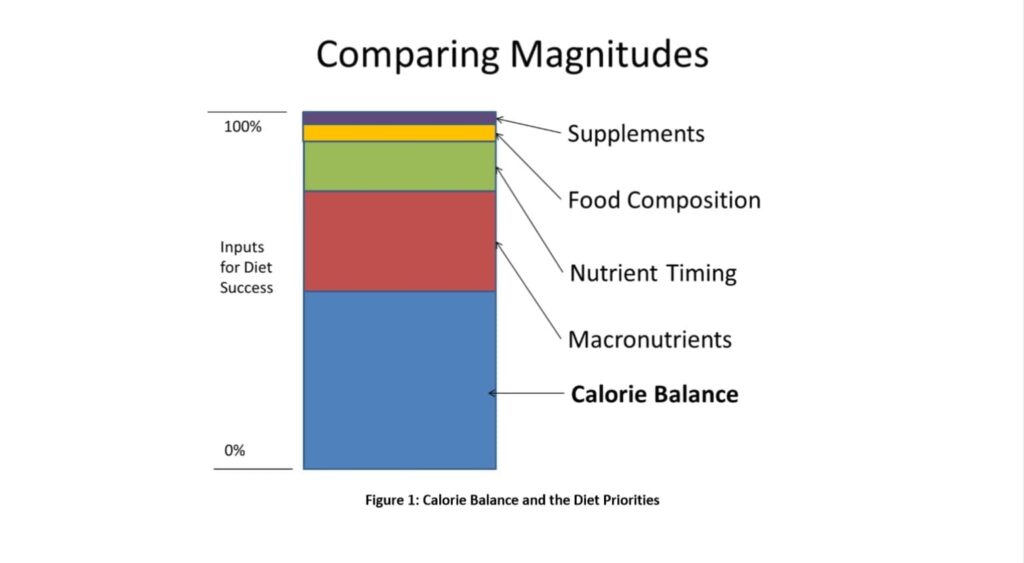You must have heard it before. Caloric deficit is the kind of word that gets thrown around when people are talking about losing weight and trying to get fitter, or at least appear fitter. And I’m here to tell you, right off the bat, that it is impossible to lose weight without being in a caloric deficit. Do I have your attention now?
You will learn what is the caloric deficit, how to calculate yours, if it is safe, what are the implications in the body, and the pros and cons of being in a caloric deficit.
Disclaimer: All content within this article is provided for general information only and should not be treated as a substitute for the medical advice of your doctor or any other health care professional.
What is Caloric Deficit?
Caloric deficit follows a fundamental law of thermodynamics. That may sound complicated, but it is not.
A caloric deficit means you are consuming less energy than what you are using throughout the day.
In other words, you are eating fewer calories than you are burning and when that happens, you are in a caloric deficit.
Some people might call it a diet and as with any diet that aims at losing weight, you must be in a caloric deficit, otherwise, you will not lose weight.
It is simple math and there are only three outcomes when consuming energy:
- Eat fewer calories (energy) than what you consume = caloric deficit
- Eat the same amount of calories (energy) that you consume = caloric balance
- Eat more calories (energy) than you consume = caloric surplus
 Source: Renaissance Periodization
Source: Renaissance PeriodizationSo if you want to lose weight, you must be in a caloric deficit. With this in mind, diets can be distinguished into three different categories: hypocaloric (lose weight), eucaloric (maintain weight), and hypercaloric (to gain weight).
Read more about the Volumetrics Diet, one of the easiest diets to follow and lose weight.
How To Calculate Caloric Deficit
The difficulty with trying to be in a caloric deficit is the many variables involved. The main question is “what is your caloric deficit?”
The caloric deficit changes from one person to another. It depends on:
- Gender
- Age
- Height
- Weight
- Physical activity level
In order to find out your caloric deficit, you must calculate your B.M.R. which stands for basal metabolic rate. This number will show the number of calories your body burns every day to keep functioning at rest. It often is described as Resting Energy Expenditure (REE) as well.
There are several online B.M.R. calculators, but you can also do it on paper utilising the Mifflin St-Jeor Equation, although it is not the most accurate way to do it.
For men:
- 10 x weight (in kilos) + (6.25 x height in centimetres) – (5 x age in years) + 5
For women:
- 10 x weight (in kilos) + (6.25 x height in centimetres) – (5 x age in years) – 161
You may also utilise Stefi Cohen’s strategy to calculate your caloric deficit.
The B.M.R. of a person changes over time and to have a more accurate reading on your personal number, consult a doctor.
 Source: i yunmai / unsplash
Source: i yunmai / unsplashWith B.M.R. in your hands, you know how many calories you need to consume for your body to function properly at rest. So, in order to lose weight, you just need to eat fewer calories than that number? In principle, yes, that is the correct assumption, but as you read a few paragraphs above, many variables come into play when we are discussing a caloric deficit.
The B.M.R. does not take into account how much and how often you work out, if your job is sitting at a desk or if it is on your feet at all times – another reason to get a doctor’s expertise on calculating your B.M.R.
Caloric Deficit – Is It Safe?
As with most things in life, extremism is not good and that certainly applies to a caloric deficit lifestyle. Some people want to lose weight and jump from a 2,700 daily calorie intake to 1,700 to shed a few kilos. That is not sustainable neither healthy.
It is advisable to be in a 500 calorie deficit to lose weight without affecting hunger or energy levels. That means if your B.M.R. is 2,900 calories, you can start limiting your daily intake to 2,400 calories to be able to lose weight sustainably and healthily.
It might be difficult for newcomers to track how many calories they eat in a meal. You can use online calorie calculators or apps and simply put in what you had in a meal that the calculator should roughly reveal the number of calories you have consumed at the end of the day.

As you lose weight, you should revaluate your B.M.R. as your maintenance calories will decrease over time.
According to the American College of Sports Medicine women should eat at least 1,200 calories per day, and men should eat at least 1,800.
By eating less than the minimum mentioned above, your body could enter a “fight or flight” stress in which it breaks down muscle in order to supply the body with enough fuel to maintain blood sugar levels while also slowing the metabolic rate to compensate for what the body perceives as starvation.
In other words, if you push to the limit of a caloric deficit, your body cells will start eating each other to survive, the minimum calories you need to survive will decrease immensely,
What Are The Implications of a Caloric Deficit?
By now you should know how many calories your body needs to keep functioning and also how many calories you should be limiting on your meals and snacks throughout the day. But what are the implications of being in a caloric deficit?
If you are reading this, probably you are not an advanced athlete preparing for a competition that requires strong muscles, because the biggest implication of being in a caloric deficit is that you will probably lose muscle mass.
 Source: CrossFit Inc
Source: CrossFit IncBy consuming less energy, your muscles will not have enough fuel to grow, thus hindering muscle growth. That is why Dwayne “The Rock” Johnson, at 42 years, consumes around 5,200 calories when he is training for a specific role that requires him to be in top shape. Mat Fraser, the most dominant athlete in CrossFit history, revealed that he would eat between 6,000 and 7,000 calories a day during his peak training.
Of course, these are athletes at a different level compared to most people in the world, but the principle is there. Being in a caloric deficit is not the way to get stronger.
Pros and Cons of a Caloric Deficit
Pros
- Lose weight – being in a caloric deficit is the only way to lose weight.
- Lower body fat – a caloric deficit will decrease your body fat, which in turn will help pop up the muscles you already got.
- Early results – if you accept and stick to a caloric deficit lifestyle, you will see results fast such as losing 2 to 5 pounds per week.
Cons
- Muscle loss – you will lose muscle mass depending on how much in a caloric deficit you are.
- Decrease in athletic performance – with less energy in the tank you will not have enough power to train as hard as you normally do.
- Too restrictive – in a caloric deficit you will probably not eat what you are used to. These food restrictions could potentially backfire and binge eating may occur.
Before deciding to get into a new diet or start a caloric deficit nutrition lifestyle, seek the professional opinion of a doctor or dietician.
Read More: How to Lose Fat and Maintain Muscle with CrossFit Training and Good Nutrition
Image Sources
- Original Priorities Chart: Renaissance Periodization
- Feet on scale weight: i yunmai / unsplash
- Crossfit-muscular-arms: CrossFit Inc
